FPV Racing
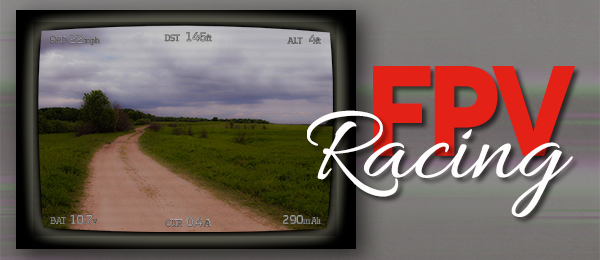
Written by Rachelle Haughn A new sport continues to evolve As seen in the June 2016 issue of Model Aviation.
Do you get an adrenaline rush when you take your model airplane out for its maiden flight? Do you ever imagine you are piloting the aircraft from the cockpit—putting on an aerial demonstration, flying in combat, or racing? At the end of your flight you receive congratulations over the radio … wait … that’s your spotter saying that you are cleared for landing. Technological advances have made it possible for you to feel as though you are in the cockpit of an aircraft. What began with attaching a still or video camera to a model airplane to get a view from the pilot’s seat has evolved into buying multirotors with tiny preinstalled cameras. Instead of standing around and waiting for your turn to take off from the flightline, you can sit on a comfy camp chair, wear a set of goggles, and your quadcopter can lift off from the grass. In addition to the amazing view from the sky, you can also race against others and win up to $1 million by doing it. You might have blinked or rubbed your eyes, but yes, you read that correctly. Welcome to the ever-growing and evolving world of multirotor FPV racing. The more you compete and win, the more money is at stake—along with bragging rights, of course. This form of racing might seem foreign and new to you, but it is quickly becoming one of the most popular activities in the US and overseas. There are several reasons for why people are deciding to take up the sport, but an obvious one is the low cost of equipment. “I’d say a fair estimate would be $300 for the goggles and the model,” stated FPV racer Matt Kloss. “[That] is pretty cheap if you compare it to anything else in the hobby.” Matt also flies model helicopters and Two-Meter Pattern (RC Aerobatics) aircraft. He said that $300 would buy a propeller for a Pattern airplane, or three servos for a helicopter. Chris Thomas, founder and president of Florida-based MultiGP, estimated the cost to get started in FPV Racing to be higher. He said the average cost for goggles is $200 to $500, and the cost for a multirotor is also $200 to $500. According to Chris, these estimates do not include the cost of a transmitter or a receiver.
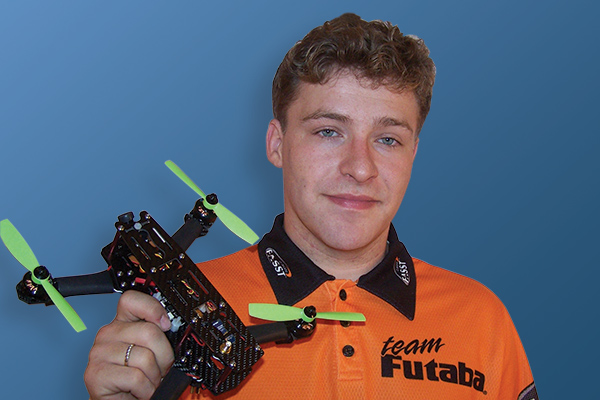
Matt Kloss, a model helicopter pilot, recently started competing in FPV multirotor racing. He finds the sport exciting and challenging. Photo provided by Matt Kloss.
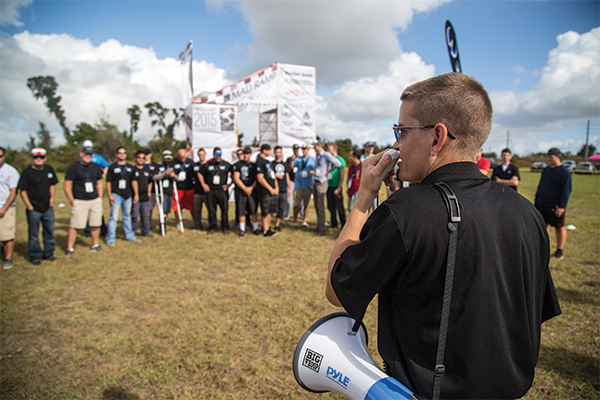
Chris Thomas, of MultiGP, addresses pilots at one of his company’s FPV multirotor races. His company designed software to make races run smoother. Photo provided by Chris Thomas.
If something goes wrong, repairing a crashed multirotor is simpler and more affordable than repairing a Pattern airplane, Matt said. “I crash [multirotors] very frequently. It’s absolutely less expensive to fix. If you crash your mulitorotor, you buy parts. If you crash an airplane, you buy a new airplane.” Lightweight, composite aircraft used for Pattern cannot be fixed, he stated. The quadcopter that Matt races the most is a ZMR 250mm, which is sold as a carbon-fiber frame with four arms. It is a mini quadcopter to which pilots must add motors, ESCs, flight controllers, standoffs, and propellers. Matt said there are several options when it comes to buying multirotors for FPV racing. Many companies sell kits that require a pilot to add his or her own hardware and electronics. There are also kits that come with everything needed to race, but require assembly. A few others come out of the box ready to fly, he added. Aside from the fact that multirotors are affordable, Matt likes FPV racing because it’s fun. “It’s pretty fast and there’s a lot of maneuverability involved. It’s pretty exciting to do,” Matt commented. Adding to the excitement is the fact that technology continues to improve, especially when it comes to the virtual-reality aspect. That’s what caught the attention of aeromodeler Scot Refsland. Scot saw a video of FPV racing online, and when he learned that the sport combined virtual reality and multirotor aircraft, “I jumped in hook, line, and sinker,” he said. Scot took up FPV racing in August 2014, after years of flying Control Line Combat, RC, gas-powered model aircraft, and gliders. Today he also co-owns a race-organizing company called RotorSports. He enjoys flying FPV with his kids.
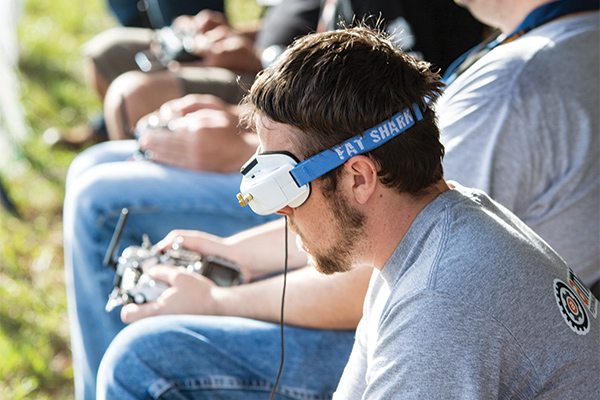
During an FPV multirotor race, pilots wear goggles that provide a view from the cockpit of their aircraft as they race around and through obstacles. Thomas photo.
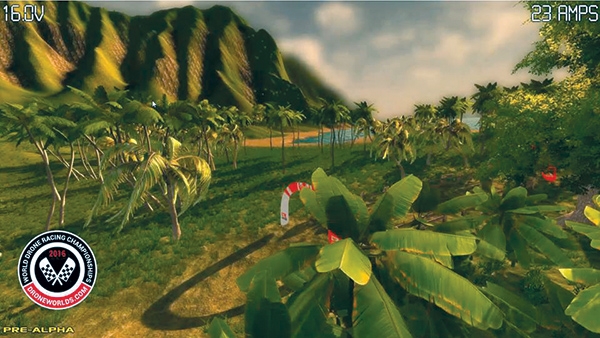
The company that Scot co-owns, RotorSports, is developing a simulator game with “to scale” environments. This screenshot is at Kualoa Ranch in Hawaii, where the first AMA-sanctioned 2016 World Drone Racing Championships will take place. Refsland photo.
Scot is creating a timeline of the history of FPV racing for AMA’s National Model Aviation Museum, located in Muncie, Indiana. He said that the first documented FPV multirotor race was held November 3, 2012, and there is an online video of the race (see the video at the end of this story). As more people learned about this exciting sport, races began popping up across the country. Those who were organizing the events quickly discovered that they needed some guidance for setting up the competitions. That’s when groups such as MultiGP; Scot’s group of FPV pilots, FPV Racers and Explorers; and the International Drone Racing Association (IDRA) began to form. Fast-forward to 2016 and there are several multirotor magazines, regional, national, and world championships for FPV racing, as well as online news programs. Multirotors are sold practically everywhere. Multirotors of all shapes and sizes were some of the hottest Christmas gifts in 2015. With the surging popularity of multirotors, AMA and other model aircraft organizations began to welcome multirotor pilots into the fold. AMA even established its own set of safety guidelines for members who choose to fly FPV. In 2015, AMA took this a step further and named MultiGP as its first FPV racing Special Interest Group.
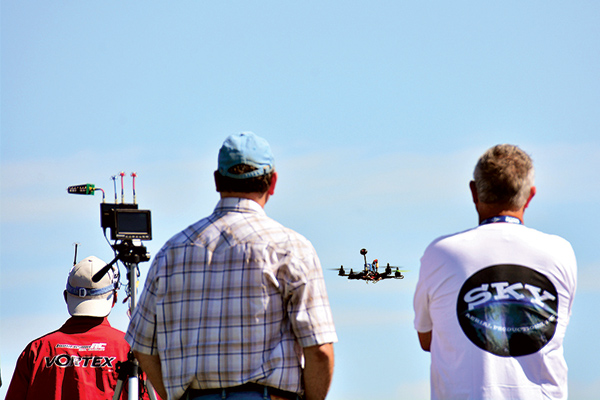
In 2015, for the first time, an FPV multirotor race was part of the International Radio Controlled Helicopter Association Jamboree. This race was held at AMA Headquarters, in Muncie IN. Photo by Jennifer Alderman.
Chris began organizing MultiGP in April 2015, after watching his first FPV race. Although he enjoyed the race and was impressed by the speed and skill involved, he wondered if there was a way to make the competition run smoother. He put together a team of professionals with the goal of creating helpful tools and resources for FPV pilots and those who were running the races. The team eventually developed frequency management software called RaceSync. It is now trademarked and used by FPV pilots and event organizers across the country. “My mission is [that] we’re trying to make a sport similar to soccer,” Chris stated. “A field in every city and a coach for every field. Safety is my number-one concern.” In addition to offering the software, MultiGP has encouraged groups of FPV racers in the US to start their own MultiGP chapters. At the time of this writing, there were 266 chapters. Since it was formed, MultiGP has held more than 2,000 races. The group will hold the 2016 Drone Racing Championship Labor Day weekend at AMA Headquarters, in Muncie, Indiana. According to MultiGP’s website, becoming a chapter has several benefits, including the use of the RaceSync software, racing gates that are easy to transport and set up, a timing system, signs, access to rules and other documents to help promote the race, and information about how to get races sponsored. It is free to form a MultiGP chapter, and is done simply by filling out an application on MultiGP’s website. Scot said that MultiGP is a great source for those who want to organize a race. He added that the IDRA is the best source for large-scale or international races. His company, RotorSports, typically helps county, state, public, or nonprofit groups set up races. The first race that RotorSports put together was the also the first “official” FPV multirotor race that AMA sanctioned. It was held April 30, 2015, at a sports stadium as part of the DATA X Conference, in Santa Cruz, California. The winner of the race was Zoe Stumbaugh and she later donated her winning Spider Hex Rat aircraft and FPV goggles to AMA’s National Model Aviation Museum. Also in 2015, the first national FPV multirotor race was held. The 2015 Fat Shark US National Drone Racing Championships took place at the California State Fair, on July 15-17. Out of the 120 pilots who competed, Chad Nowak, aka FinalGlideAUS, took the top spot. Michael Smith, National Model Aviation Museum director, said that Scot is working to get Chad’s multirotor donated to the museum.
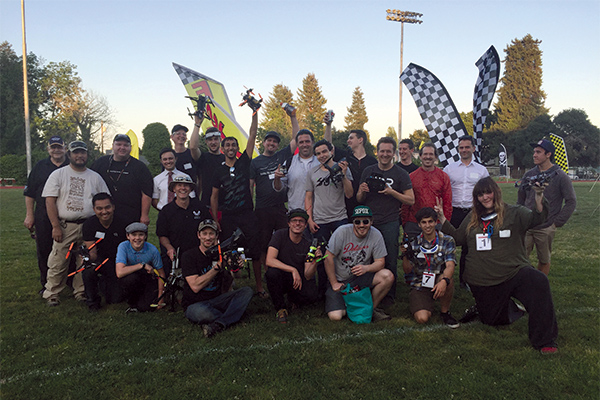
The first official drone race that AMA sanctioned was held in Santa Cruz CA. Zoe Stumbaugh (front, far R) won the race and later donated her quadcopter to AMA’s National Model Aviation Museum. Also pictured is Rich Hanson (back row, far L), AMA’s Government and Regulatory Affairs Representative. Refsland photo.
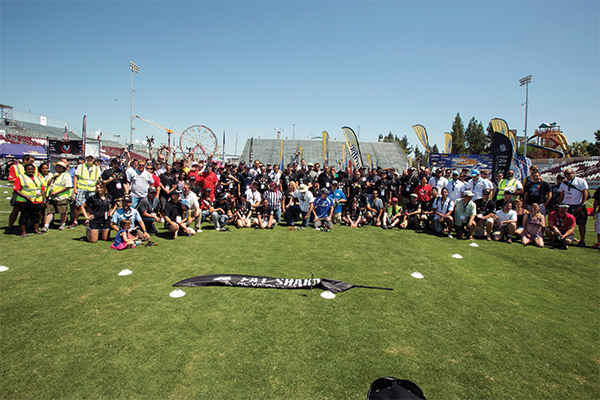
The inaugural US National Drone Racing Championships was held July 15-17 at the California State Fair. This year’s competition will take place in New York City. Scot Refsland photo.
This year, FPV multirotor races are expected to be bigger and the stakes will be higher. The World Drone Prix, that was held March 11-12 in Dubai United Arab Emirates, had $1 million in prize money. To qualify for this competition, teams had to compete in other races throughout the world. Several Americans were among those who raced in the World Drone Prix. Later this year, pilots from more than 30 countries are expected to travel to Kualoa Ranch, Hawaii, to compete for $200,000 in prizes. The 2016 World Drone Racing Championships, an AMA-sanctioned race, will be held October 17-22. Kualoa Ranch has been the filming location for several popular movies, such as Jurassic Park and Godzilla. Any FPV race that is sanctioned by AMA requires the racers to have an AMA membership. On a smaller scale, the AMA-sanctioned US National Drone Racing Championships will be held August 5-7 in New York City. Teams will be vying for a cool $50,000. At this point, you might be seeing dollar signs and wondering how you can get started in this popular and exciting sport. You should know that whether you have flown model aircraft in the past, or if you have never touched a transmitter in your life, doesn’t seem to matter. Multirotor FPV races are set up as a course with obstacles. The obstacles can be manmade, such as circles or gates to go through, or bridges to fly under. Some are natural obstacles including trees and rivers. The pilot flies the entire race from the view of the cockpit using goggles, and what he or she sees can be displayed on a special monitor, such as a tablet. “When you race, you’re kind of numb to the world, I guess. The time you land is kind of when the adrenaline hits because you realize if you lost or won,” Matt said of the experience. At the time of this writing, he had participated in nine FPV races. The races are timed and broken into heats. The pilots are separated into classes based on either the battery and propeller size or the size of the multirotors that are being flown. The pilots in each class race against each other in a heat. The races in which Matt has flown have had an open class, a class for multirotors with 5-inch propellers and 3S LiPo batteries, a class for multirotors that are 250mm diagonal or more from motor to motor, and those that are less than 250mm. Matt said that there is often a winner in each class. MultiGP breaks its races into classes based on aircraft specifications. There is a 3S class, a 4S class, and an open class. The 3S class is designed for beginners, and the aircraft use 3S LiPo batteries. The multirotors in the 4S class, which is tailored for advanced FPV racing pilots, have 4S LiPo batteries. The open class is available to all multirotors and is “designed to promote competition between all styles and configurations of aircraft to help evolve innovation in technology and design,” according to MultiGP’s website. In addition to MultiGP, Ready Made RC coordinates FPV races. Matt said he has flown in races coordinated by both companies, and all were well organized. MultiGP’s timing system for races is installed on the start/finish gate. Each pilot’s lap time is tracked through a small, lightweight sensor that is attached to the aircraft. This data is transmitted to a laptop computer for the judges to view. The pilot with the fastest time wins.
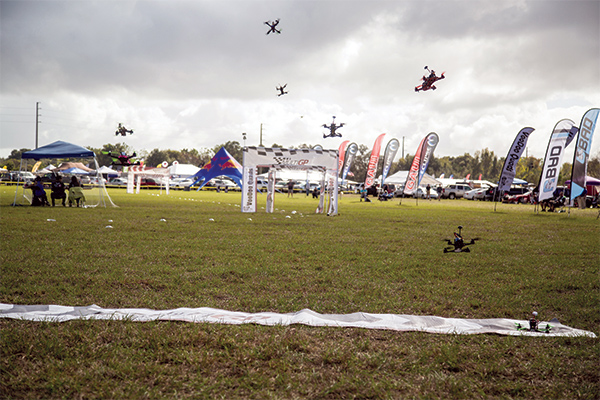
This is what the takeoff area looks like at a race run by MultiGP. The first obstacle that the multirotors must go through is a starting gate. This gate has sensors on it that track the multirotors’ times. Thomas photo.
The fastest times appear to be getting faster. According to Scot, his company designs its FPV racing courses to limit the aircraft’s top speeds to 60 mph. In the most recent race that Scot’s company organized, “the racers clocked 90 to 100 mph,” he said. Scot noted that one of his goals is to get more national exposure for the sport. He would like to see FPV races broadcast on sports and news networks and find a way to better engage spectators. He believes that FPV will continue to grow and thrive. If being a spectator is not enough and you want to play a bigger part in the hottest new sport in the US, getting started in FPV multirotor racing is probably easier than you expect. Matt suggested that those who are interested start by joining a local multirotor club and spending some time at the group’s flying site. He said clubs are good at giving new pilots advice and tips. Scot suggested that pilots begin by holding casual weekend races. From there, they can start an online meetup group or form a MultiGP chapter. So, what are you waiting for? It’s time to connect your batteries, put on some goggles, and get your adrenaline rush on with FPV racing! —Rachelle Haughn [email protected]










2 comments
Drone Worlds links
Links
Add new comment